#biotechnology science
Text
Which search engine is best for academic research? Hint: It's not Wikipedia

PubMed
PubMed is a free resource supporting the search and retrieval of biomedical and life sciences literature with the aim of improving health–both globally and personally.
The PubMed database contains more than 34 million citations and abstracts of biomedical literature. It does not include full-text journal articles; however, links to the full text are often present when available from other sources, such as the publisher's website or PubMed Central (PMC).
Available to the public online since 1996, PubMed was developed and is maintained by the National Center for Biotechnology Information (NCBI), at the U.S. National Library of Medicine (NLM), located at the National Institutes of Health (NIH).
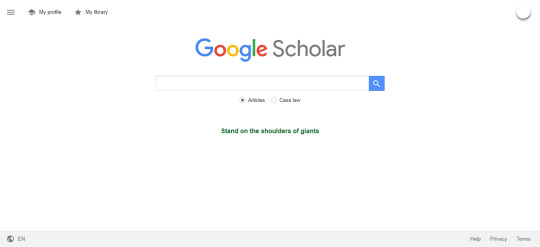
Google Scholar
Google Scholar provides a simple way to broadly search for scholarly literature. From one place, you can search across many disciplines and sources: articles, theses, books, abstracts, and court opinions, from academic publishers, professional societies, online repositories, universities, and other websites. Google Scholar helps you find relevant work across the world of scholarly research.

Semantic Scholar
Semantic Scholar provides free, AI-driven search and discovery tools, and open resources for the global research community. With Semantic Scholar, researchers can understand a paper at a glance. Our system extracts meaning and identifies connections from within papers, then surfaces these insights to help Scholars discover and understand research.
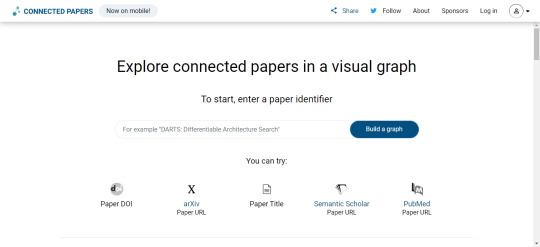
Connected Papers
Connected Papers is a unique, visual tool to help researchers and applied scientists find and explore papers relevant to their field of work.
Research Rabbit
Research Rabbit is starting with our Discovery app which unlocks a completely novel way to search for papers and authors, monitor new literature, visualize research landscapes, and collaborate with colleagues.
#pubmed#google scholar#semanticscholar#research rabbit#connected papers#researchers#research paper#research#biotechnology#biotech#science#biology#biochemistry#studyblr#molecularbiology#notes#class notes#students#biotechnology science#useful information#search engines & search marketing#search engine#phd scholar#phd#phd candidate#thesis#university#grad school#phd topics#wikipedia
995 notes
·
View notes
Text


tweet
#trans#this is the future#genderless#the future is genderless#science#biotechnology#ai#robotics#transhumanism#posthumanism#mine#tweets
4K notes
·
View notes
Text
Researchers have genetically engineered a marine microorganism to break down plastic in salt water. Specifically, the modified organism can break down polyethylene terephthalate (PET), a plastic used in everything from water bottles to clothing that is a significant contributor to microplastic pollution in oceans.
"This is exciting because we need to address plastic pollution in marine environments," says Nathan Crook, corresponding author of a paper on the work and an assistant professor of chemical and biomolecular engineering at North Carolina State University.
"One option is to pull the plastic out of the water and put it in a landfill, but that poses challenges of its own. It would be better if we could break these plastics down into products that can be re-used. For that to work, you need an inexpensive way to break the plastic down. Our work here is a big step in that direction."
To address this challenge, the researchers worked with two species of bacteria. The first bacterium, Vibrio natriegens, thrives in saltwater and is remarkable—in part—because it reproduces very quickly. The second bacterium, Ideonella sakaiensis, is remarkable because it produces enzymes that allow it to break down PET and eat it.
Continue Reading
422 notes
·
View notes
Text
made minos prime out of gmo e. coli
#ultrakill#minos prime#ultrakill minos#biotechnology#bioengineering#i was gifted with the science autism#and i use it for fanart
93 notes
·
View notes
Text
Epigenetics: A Journey Through Inheritance Beyond Genes
For centuries, scientists have been fascinated by the mysteries of heredity and how traits are passed down from generation to generation. DNA, the molecule that stores our genetic code, was once thought to be the sole determinant of our characteristics. However, a new frontier in biology, revealing a captivating layer of complexity beyond the DNA sequence itself: Epigenetics.
What is Epigenetics?
The term "epigenetics" was first coined in the 1940s by British biologist Conrad Waddington, but it wasn't until the late 20th century that its significance truly blossomed. Epigenetics, literally meaning "above genetics," refers to the study of heritable changes in gene expression that occur without alterations to the DNA sequence itself. Imagine DNA as the musical score, but epigenetics are the conductor and musicians who determine how the music is played. Through chemical modifications and adjustments to the proteins around DNA, epigenetics dictates which genes are turned on or off, influencing how cells function and ultimately shaping our health, development, and even behavior. Think of your DNA as the hardware: it contains the basic instructions for building and running your body. But epigenetics acts like the software, fine-tuning those instructions and determining which genes get turned on or off at specific times and in specific cells. These modifications, like chemical tags or changes in the packaging of DNA, don't alter the underlying code itself, but they can have a profound impact on how it's read and interpreted.
The Key Players:
DNA methylation: This process involves adding a methyl group to DNA, essentially silencing the gene it's attached to. Imagine it like putting a dimmer switch on a light bulb.
Histone modifications: Histones are proteins that package DNA, and changes in their structure can make genes more or less accessible to the cellular machinery needed for expression. Think of it like adjusting the curtains around a window - open wide for full light, slightly closed for filtered light.
Non-coding RNAs: These are molecules that don't code for proteins but can regulate gene expression in various ways. They're like the backstage crew in a play, ensuring everything runs smoothly.
The Power of Epigenetic Regulation
Epigenetic regulation plays a crucial role in various biological processes, including:
Development: During embryonic development, different cell types emerge from the same DNA blueprint by activating or silencing specific gene sets through epigenetic modifications.
Cellular differentiation: Specialized cells like muscle or nerve cells have unique functions due to differences in their active genes, controlled by epigenetic mechanisms.
Learning and memory: Epigenetic changes in brain cells are thought to be essential for learning and forming memories.
Aging: As we age, our epigenome accumulates changes that can contribute to age-related decline and disease.
Environmental influences: Diet, exercise, stress, and exposure to toxins can leave epigenetic marks on our genes, potentially impacting our health and even the health of future generations.
Epigenetics reminds us that we are not simply products of our genes. Our environment, choices, and experiences leave their mark, shaping who we are and potentially influencing our children's health. This deeper understanding of ourselves opens doors for self-awareness, empowerment, and potentially reshaping our narratives – not just as individuals, but as a species with the potential to leave a healthier legacy for generations to come.
#life science#biology#science sculpt#molecular biology#biotechnology#epigenetics#daily dose of science#dna#genetic inheritance#genetics#decoding dna#genetic code#science#double helix
104 notes
·
View notes
Text
#biology#medicalschool#biotech#science#health#biologyisawesome#biologyisfun#education#celldivision#mitosis#biologystudent#cellbiology#biology facts#lifesciences#stem#biotechnology#college prep#chemistry#maths#math#motivation
1K notes
·
View notes
Text
for someone who loves computers and wishes i could be one i sure do fucking suck at math
140 notes
·
View notes
Text
Calling all science students and enthusiasts!!
I would absolutely love to have a science-revolving passion project and I’ve narrowed it down to a blog/blog-type-website. I love learning about science but so rarely take the time to actually research the things that interest me. With being a high school student, exams and life this is quite a big task to handle for 1 person and I’d love others to contribute to this!
This is by no means a set plan yet, I’m just sharing a rough idea, so if you could please interact with this post or dm me if you would be interested in something of this kind. Even if you see this 5 months after this was posted (and hopefully a working project or at least WIP) still reach out if you’re interested.
You don’t have to be a great writer for this either nor fascinated about each and every science. My favourite is chemistry, but it would be nice if this project could incorporate the 3 main branches of science: biology, chemistry and physics. It depends on if people would be interested in reading something like this or participating in, and their preferred subjects. You could write about astronomy as a whole, or go into chemistry and analysing electronic configuration, talking about your favourite dinosaur bones in palaeontology, a passive behaviour analysis in psychology, or explaining how exactly scabs work in biology. These would probably be short to mid-length entries and 1/2 times a month.
But this is just my idea and how far I’ve gone with it, feedback is appreciated, there will be more updates to come (not too many until afer my exams in May tho), and I appreciate any reblogs to share this idea with others!
Hopefully a couple people would like to help out in this project and please ask questions if you have any (as a dm or ask) ^^
#studyblr#uni student#university#student#a levels#science#passion project#group project#chemistry#biology#physics#medicine#astronomy#psychology#Sociology#palaeontology#botany#microbiology#toxicology#biotechnology#geology#meteorology#earth science#biochemistry#dark academia#light academia#community project#scienceblr#science blog#the sci journal
93 notes
·
View notes
Text
I hate that in the popular vision of biopunk, "biological machines" and biotech look like gross body horror nonsensical pieces of crap with no rhyme or reason
(bioforges from Orion's Arm)
When the most efficient "biomachines" we know, able to turn mere air water and sunlight into all sorts of useful products, look like this:

#cosas mias#biopunk#science fiction#I hate that biopunk in the general science fiction conscioness is all about gross body horror#and not the potential of biotechnology to change our daily lives#worldbuilding#body horror tw
111 notes
·
View notes
Text
#memecular biology#science side of tumblr#science stuff#lab life#fume hood#bio lab#scientist#science memes#lab meme#lab memes#science meme#haley meming#meming from the lab#biologist#molecular biology#bio memes#biotech#biology#biotechnology#mol bio#biochem humor#bio humor#memes#nerd culture#nerdy jokes#nerdiness#nerdy#nerd memes#nerd meme#nerd humor
276 notes
·
View notes
Text
These words will be very useful for you in writing especially in academic writing.
.
Sentence Starters
.
I help researchers increase engagement with their work. Together we will transform your ideas into unique and intuitive graphics with my reliable process:
1-Pinpoint your goals
2-Sketch and prototype
3-Discuss and iterate
4-Goal accomplished
.
𝐇𝐈𝐑𝐄 𝐌𝐄 (DM Your Design Projects)
.
💎Here to HELP You:
✔️Graphical Abstract Design
✔️Journal Figures Design
✔️Scientific Illustration
✔️Flyer and Poster Design
✔️Infographic Design
✔️Slides Design
#writing tips#writing tools#academic writing#creative writing#writers block#writing#writeblr#biotechnology science#biochemistry#biotech#biology#molecularbiology#biotechnology#bioinformatics#biotech and pharmaceuticals#graphics#science illustration#scientific illustration#illustration#illustragram#commissions#commission open#open commissions#commissions open
117 notes
·
View notes
Link
Microscopy has revolutionized our understanding of the world, allowing us to peer into the intricate details of cells, tissues, and even viruses. However, obtaining precise measurements in these minute worlds is quite difficult. Just like fog can make distant objects look different from reality, so does the light treatment of samples in microscopes, which makes them compressed or elongated along the depth axis especially. For decades now, this problem, known as refractive index mismatch (RIM), has troubled researchers.
Recently, there was a breakthrough at Delft University of Technology. In their work published in Optica journal, they present an innovative approach that could be used to determine depth-dependent re-scaling factors, which are very important in correcting distortions caused by RIM. This blog post delves into the complexities of RIM, explores existing approaches to deal with it, and explains how this new method is changing the world of microscopy.
Continue Reading
41 notes
·
View notes
Text
Diabetes is a condition in which the body produces too little or no insulin. Diabetics thus depend on an external supply of this hormone via injection or pump.
Researchers led by Martin Fussenegger from the biosystems science and engineering department at ETH Zurich in Basel, Switzerland want to make the lives of people with diabetes easier and are looking for solutions to produce and administer insulin directly in the body.
One such solution the scientists are pursuing is enclosing insulin-producing designer cells in capsules that can be implanted in the body. To be able to control from the outside when and how much insulin the cells release into the blood, researchers have studied and applied different triggers in recent years: light, temperature, and electric fields.
Fussenegger and his colleagues have now developed another, novel stimulation method: they use music to trigger the cells to release insulin within minutes. This works especially well with “We Will Rock You,” a global hit by British rock band, Queen.
To make the insulin-producing cells receptive to sound waves, the researchers used a protein from the bacterium E. coli. Such proteins respond to mechanical stimuli and are common in animals and bacteria. The protein is located in the membrane of the bacterium and regulates the influx of calcium ions into the cell interior. The researchers have incorporated the blueprint of this bacterial ion channel into human insulin-producing cells. This lets these cells create the ion channel themselves and embed it in their membrane.
Continue Reading
487 notes
·
View notes
Text
A species of spider lives its entire life underwater, despite having lungs that can only breathe atmospheric oxygen. How does it do it? This spider, known as the Argyroneta aquatica, has millions of rough, water-repellent hairs that trap air around its body, creating an oxygen reservoir and acting as a barrier between the spider’s lungs and the water. This thin layer of air is called a plastron and for decades, material scientists have been trying to harness its protective effects.
40 notes
·
View notes
Text







Stem Academia | My degree as aesthetic | Do repost with yours!!
#academia aesthetic#studyblr#study notes#studying#women in stem#stem academia#stem moodboard#stem student#science#programming#computational biology#biotechnology#biotech#study aesthetic#research#molecular biology#genetics#degree as aesthetic
101 notes
·
View notes
Text
Biology Bytes #3 - Taxonomic Categories
⚗️🦠🔬🧬🧫
Domain (Dancing)
Kingdom (Kids)
Phylum (Prefer)
Class (Candy)
Order (Over)
Family (Fried)
Genus (Green)
Species (Spinach)
⚗️🦠🔬🧬🧫
Photo credits:
Dancing children
Candy
Fried Spinach
Follow @studyhaus for more concise summaries of concepts in biology!




#biology homework help#biotechnology#biology student#biology#stem#science#studyblr#study#knowledge#learning#learn#high school#college#university#student#study aesthetic#study blog#studying#students#study motivation#study notes#study tips#student life
84 notes
·
View notes